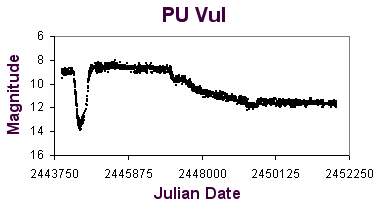PU Vul (Nova Vulpeculae 1979)
PU Vul was discovered by Y. Kuwano of Hita, Japan, at photographic magnitude 9.0 on 1979 April 5.83 UT (AAVSO Alert Notices 28, 195). In a separate report issued at a later date, an independent discovery was announced in which Minoru Honda, Kurashiki, Japan found the star to be located on an exposure of the field with Tri-X film taken on 1978 Aug 21.515 UT, at which time it was seen at magnitude 10 (see IAU Circulars 3344 and 3348).
 |
| Visual light curve of PU Vul from the AAVSO International Database; August 29, 1978, to December 6, 2001. |
PU Vul is a symbiotic nova, of which there are only a few known. Symbiotic novae are similar to classical novae in that they are composed of the close binary system and the thermonuclear outburst mechanism still applies. However, the symbiotic systems house an evolved giant star as the secondary component, rather than a Sun-like star.
The light curve of PU Vul displays slow evolutionary changes in comparison with some of the other types of novae. Aside from the deep minimum seen to have occured between March 1980 and June 1981, maximum brightness was maintained for nearly a decade before the gradual fading began in 1988. In 1994, PU Vul underwent another minimum during which its spectrum as well as the shape of the light curve proved to support the eclipse of the white dwarf star (Garnavich 1996). Garnavich calculated the period of the eclipse to be 13.42 +/- 0.02 years. As such, the next eclipse is expected to occur in February of 2007.
The nova can be found in the constellation of Vulpecula, close to the imaginary constellation boundary lines where Vulpecula, Delphinus, and Sagittarius meet.
The past 20+ years of monitoring have resulted in over 15,700 observations in the AAVSO International Database. With such a wealth of data, the AAVSO published a Monograph containing the light curve of PU Vul from 1979 through 1995, and a supplement in 2001 containing data for 1996 to 2000.

